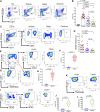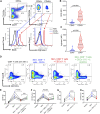Differential Impact of SARS-CoV-2 Isolates, Namely, the Wuhan Strain, Delta, and Omicron Variants on Erythropoiesis
- PMID: 35943266
- PMCID: PMC9430111
- DOI: 10.1128/spectrum.01730-22
Differential Impact of SARS-CoV-2 Isolates, Namely, the Wuhan Strain, Delta, and Omicron Variants on Erythropoiesis
Abstract
SARS-CoV-2 variants exhibit different viral transmissibility and disease severity. However, their impact on erythropoiesis has not been investigated. Here, we show SARS-CoV-2 variants differentially affect erythropoiesis. This is illustrated by the abundance of CD71+ erythroid cells (CECs) in the blood circulation of COVID-19 patients infected with the original Wuhan strain followed by the Delta and Omicron variants. We observed the CD45+CECs are the dominant subpopulation of CECs expressing the receptor, ACE2, and coreceptor, TMPRSS2, and thus, can be targeted by SARS-CoV-2. Also, we found CECs exhibit immunosuppressive properties, specifically CD45+CECs are the dominant immunosuppressive cells and via reactive oxygen species (ROS) and arginase I expression can impair CD8+ T cell functions. In agreement, we observed CECs suppress CD8+ T cell effector (e.g., Granzyme B expression and degranulation capacity [CD107]), which was partially but significantly reversed with l-arginine supplementation. In light of the enriched frequency of CECs, in particular, CD45+CECs in patients infected with the original (Wuhan) strain, we believe this strain has a more prominent impact on hematopoiesis compared with the Delta and Omicron variants. Therefore, our study provides an important insight into the differential impact of SARS-CoV-2 variants on erythropoiesis in COVID-19 patients. IMPORTANCE Silent hypoxia has been the hallmark of SARS-CoV-2 infection. Red blood cells (RBCs) work as gas cargo delivering oxygen to different tissues. However, their immature counterparts reside in the bone marrow and normally absent in the blood circulation. We show SARS-CoV-2 infection is associated with the emergence of immature RBCs so called CD71+ erythroid cells (CECs) in the blood. In particular, we found these cells were more prevalent in the blood of those infected with the SARS-CoV-2 original strain (Wuhan) followed by the Delta and Omicron variants. This suggests SARS-CoV-2 directly or indirectly impacts RBC production. In agreement, we observed immature RBCs express the receptor (ACE2) and coreceptor (TMPRSS2) for SARS-CoV-2. CECs suppress T cells functions (e.g., Granzyme B and degranulation capacity) in vitro. Therefore, our study provides a novel insight into the differential impact of SARS-CoV-2 variants on erythropoiesis and subsequently the hypoxia commonly observed in COVID-19 patients.
Keywords: Delta; Omicron; SARS-CoV-2; SARS-CoV-2 variants; Wuhan; erythropoiesis.
Conflict of interest statement
The authors declare no conflict of interest.
Figures


Similar articles
-
Haematological Manifestations of SARS-CoV-2: Insights into Erythropoiesis, Hepcidin Regulation, and Cytokine Storm.Int J Mol Sci. 2025 Jan 21;26(3):874. doi: 10.3390/ijms26030874. Int J Mol Sci. 2025. PMID: 39940645 Free PMC article. Review.
-
Erythroid precursors and progenitors suppress adaptive immunity and get invaded by SARS-CoV-2.Stem Cell Reports. 2021 May 11;16(5):1165-1181. doi: 10.1016/j.stemcr.2021.04.001. Stem Cell Reports. 2021. PMID: 33979601 Free PMC article.
-
Analysis of SARS-CoV-2 isolates, namely the Wuhan strain, Delta variant, and Omicron variant, identifies differential immune profiles.Microbiol Spectr. 2023 Sep 7;11(5):e0125623. doi: 10.1128/spectrum.01256-23. Online ahead of print. Microbiol Spectr. 2023. PMID: 37676005 Free PMC article.
-
Sex Matters: Physiological Abundance of Immuno-Regulatory CD71+ Erythroid Cells Impair Immunity in Females.Front Immunol. 2021 Jul 21;12:705197. doi: 10.3389/fimmu.2021.705197. eCollection 2021. Front Immunol. 2021. PMID: 34367164 Free PMC article.
-
The role of CD71+ erythroid cells in the regulation of the immune response.Pharmacol Ther. 2021 Dec;228:107927. doi: 10.1016/j.pharmthera.2021.107927. Epub 2021 Jun 24. Pharmacol Ther. 2021. PMID: 34171326 Review.
Cited by
-
The oxygen dissociation curve of blood in COVID-19-An update.Front Med (Lausanne). 2023 Feb 27;10:1098547. doi: 10.3389/fmed.2023.1098547. eCollection 2023. Front Med (Lausanne). 2023. PMID: 36923010 Free PMC article. Review.
-
Immunoregulatory properties of erythroid nucleated cells induced from CD34+ progenitors from bone marrow.PLoS One. 2023 Jun 30;18(6):e0287793. doi: 10.1371/journal.pone.0287793. eCollection 2023. PLoS One. 2023. PMID: 37390055 Free PMC article.
-
SARS-CoV-2 pseudovirus dysregulates hematopoiesis and induces inflammaging of hematopoietic stem and progenitor cells.Exp Mol Med. 2025 Mar;57(3):616-627. doi: 10.1038/s12276-025-01416-1. Epub 2025 Mar 3. Exp Mol Med. 2025. PMID: 40025168 Free PMC article.
-
Differential effects of age, sex and dexamethasone therapy on ACE2/TMPRSS2 expression and susceptibility to SARS-CoV-2 infection.Front Immunol. 2022 Nov 3;13:1021928. doi: 10.3389/fimmu.2022.1021928. eCollection 2022. Front Immunol. 2022. PMID: 36405732 Free PMC article.
-
Haematological Manifestations of SARS-CoV-2: Insights into Erythropoiesis, Hepcidin Regulation, and Cytokine Storm.Int J Mol Sci. 2025 Jan 21;26(3):874. doi: 10.3390/ijms26030874. Int J Mol Sci. 2025. PMID: 39940645 Free PMC article. Review.
References
-
- Thomas T, Stefanoni D, Dzieciatkowska M, Issaian A, Nemkov T, Hill RC, Francis RO, Hudson KE, Buehler PW, Zimring JC, Hod EA, Hansen KC, Spitalnik SL, D’Alessandro A. 2020. Evidence for structural protein damage and membrane lipid remodeling in red blood cells from COVID-19 patients. medRxiv. - PMC - PubMed
-
- Foy BH, Carlson JCT, Reinertsen E, Padros I Valls R, Pallares Lopez R, Palanques-Tost E, Mow C, Westover MB, Aguirre AD, Higgins JM. 2020. Association of red blood cell distribution width with mortality risk in hospitalized adults with SARS-CoV-2 infection. JAMA Netw Open 3:e2022058. doi:10.1001/jamanetworkopen.2020.22058. - DOI - PMC - PubMed
Publication types
MeSH terms
Substances
Supplementary concepts
Grants and funding
LinkOut - more resources
Full Text Sources
Medical
Research Materials
Miscellaneous

